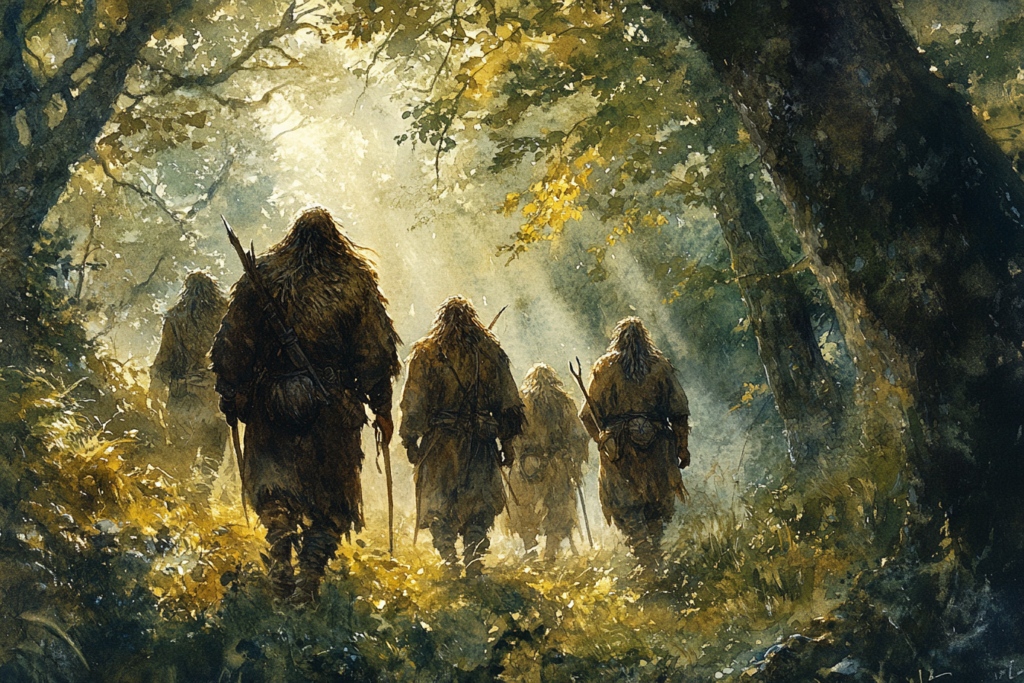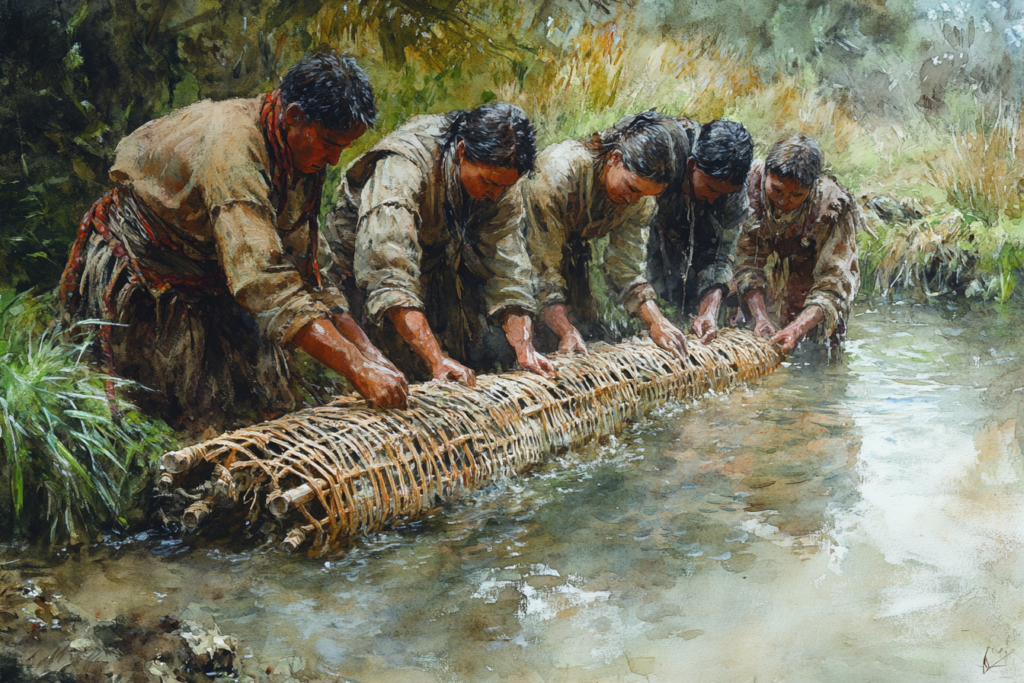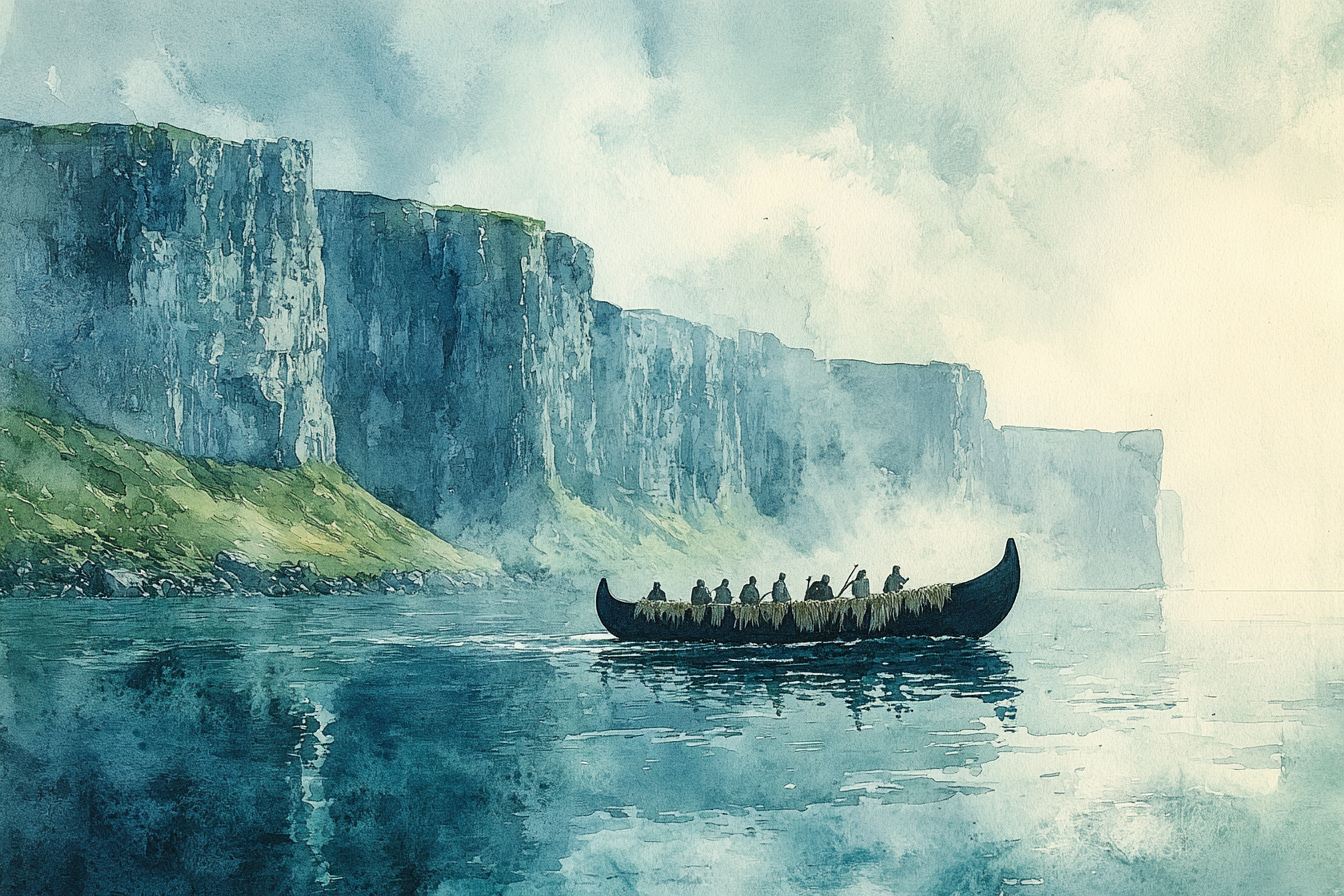The Mesolithic period, or Middle Stone Age, represents a pivotal stage in human history, serving as a bridge between the Palaeolithic and Neolithic periods. In Ireland, this era is generally recognised as spanning from approximately 10,000 to 6,000 years ago, with the earliest substantial evidence of settlement appearing around 8000 BC (Heritage Council of Ireland, n.d.). This report explores the archaeology of Mesolithic Ireland, focusing on the earliest hunter-gatherer settlements around 8000 BC. It examines the archaeological evidence, environmental context, social organisation, and the eventual transition to the Neolithic period.
Arrival and Early Settlements
While the Mesolithic period in Ireland is generally thought to have begun around 8000 BC, evidence suggests human presence on the island may date back even further. A bear bone discovered in Alice & Gwendoline Cave, County Clare, bearing distinctive cut marks from stone tools, has been dated to approximately 12,500 years ago (Dowd, 2016). This finding places humans in Ireland during the Palaeolithic era, pushing back the timeline of human activity on the island.

More substantial evidence for settlement emerges around 8000 BC, with the arrival of hunter-gatherers, most likely travelling by boat from Britain (Your Irish Culture, n.d.). However, it’s also possible that some migration occurred from Wales and southwest England, adding to the genetic and cultural diversity of these early settlers (Johnston, n.d.). These early inhabitants relied on the island’s natural resources for survival, establishing settlements near water sources such as rivers and lakes. These locations provided abundant food and convenient transportation routes (Mesolithic Period In Ireland, n.d.).
The fact that Ireland was an island during this period had significant implications for these early communities. It likely presented challenges in terms of isolation and limited contact with other populations. However, it also fostered a strong reliance on marine resources and the development of seafaring technology, which would have been essential for their arrival and subsequent movement around the island.
One of the most important Mesolithic sites in Ireland is Mount Sandel in County Londonderry (Wikipedia, 2024). Excavations at this site have revealed the remains of Mesolithic huts and charcoal from cooking fires, offering valuable insights into the living conditions and daily activities of these early inhabitants (Johnston, n.d.). Other significant sites include the cremations at Hermitage in County Limerick and the campsite at Lough Boora in County Offaly (Wikipedia, 2024). These sites, along with numerous lithic scatters found across the island, illustrate the widespread presence of hunter-gatherers in Mesolithic Ireland (Wikipedia, 2024).
Archaeological Evidence
Archaeological investigations have unearthed a variety of artifacts that shed light on the lifestyle and culture of Mesolithic hunter-gatherers in Ireland. These can be categorised as follows:
Lithic Tools
In Ireland, the Mesolithic has been divided into earlier and later phases based on changes in stone tool technology (Heritage Council of Ireland, n.d.). Flint tools, such as scrapers, arrowheads, and blades, are among the most common finds at Mesolithic sites. These tools were essential for hunting, fishing, and processing food (Wikipedia, 2024). The “Moss-side hoard” of Mesolithic Bann flake tools and blades, housed in the Ulster Museum, is a notable example of such finds (Wikipedia, 2024). The development of microliths, small and finely crafted stone tools, reflects an improvement in hunting and fishing techniques during the later Mesolithic (Heritage Council of Ireland, n.d.).
| Tool Type | Description | Use |
|---|---|---|
| Scrapers | Flaked stone tools with a sharp edge | Scraping hides, woodworking |
| Arrowheads | Small, pointed flint tools | Hunting |
| Blades | Thin, sharp-edged flakes | Cutting, slicing |
| Microliths | Small, geometrically shaped tools | Hunting, fishing, as components of composite tools |
Middens
Middens, essentially ancient refuse heaps, contain discarded shells, animal bones, and other organic materials. These provide valuable information about the diet and subsistence strategies of Mesolithic people (Irish Archaeology, n.d.). Coastal midden sites like those found in Errismore, Connemara, and Ferriters Cove offer insights into the exploitation of marine resources (Gibbons, n.d.).
Burials
Mesolithic burials are relatively rare in Ireland. However, the discovery of cremated remains at Hermitage, County Limerick, is of great significance. This site, potentially the oldest cemetery in Ireland, provides crucial evidence of mortuary practices and potential social hierarchies (Your Irish Culture, n.d.). The presence of polished stone axes alongside these burials suggests the importance of these tools in their culture and perhaps even in their belief systems (Gibbons, n.d.).
Variety of Sites
The variety of Mesolithic sites discovered in Ireland reflects the adaptability of these early hunter-gatherers to different environments. For example, ‘The Curran’ near Larne in County Antrim is a raised beach where archaeologists have found thousands of flint tools (Johnston, n.d.). This highlights the importance of coastal areas for resource exploitation and tool production.
Fishing Technology
The Mesolithic people also developed specialised technology for fishing. Evidence of fish traps has been found, demonstrating their ingenuity in harnessing the resources of rivers and coastal waters (Gibbons, n.d.).
Environmental Context
The environmental context of Mesolithic Ireland played a crucial role in shaping the settlement patterns and subsistence strategies of hunter-gatherers. Following the end of the last Ice Age around 8000 BC, Ireland underwent significant environmental changes (Wikipedia, 2024). The climate became warmer, leading to the expansion of forests and an increase in the diversity of flora and fauna (Mesolithic Period In Ireland, n.d.).

However, this period was not without its environmental challenges. The Younger Dryas stadial, a period of climatic instability between approximately 12,900 and 11,700 years ago, brought a return to colder conditions (Heritage Council of Ireland, n.d.). This would have had a significant impact on the environment and human activity, potentially disrupting settlement patterns and resource availability.
Despite these challenges, the overall warming trend led to new opportunities for hunter-gatherers. The abundance of wildlife, including wild boar, birds, and fish, offered a rich source of food (Wikipedia, 2024). Interestingly, there is no evidence of deer in the Irish Mesolithic, suggesting they may not have been present on the island at that time (Wikipedia, 2024). This absence would have influenced the hunting strategies of Mesolithic people, perhaps leading them to focus on other prey animals or develop specialised techniques for hunting smaller game. The availability of hazelnuts and other plant resources further supplemented their diet (Wikipedia, 2024).
The Role of Waterways
Waterways, such as rivers and lakes, were central to the lives of Mesolithic people in Ireland. They not only provided a source of food but also facilitated transportation and communication (Your Irish Culture, n.d.). Rivers like the Shannon and the Bann would have been important arteries for movement and trade, connecting different communities across the island.
Rising Sea Levels
The environmental changes of the Mesolithic also included rising sea levels. Evidence of this can be seen in the drowned field system in the Aran Islands (Gibbons, n.d.). This suggests that some Mesolithic settlements may have been submerged as the coastline changed, highlighting the dynamic relationship between human communities and their environment.
Social Organisation and Technology
Due to the limited archaeological evidence, reconstructing the social organisation and belief systems of Mesolithic communities in Ireland remains a challenge. However, comparative studies with other Mesolithic cultures in Europe suggest that they likely lived in small, mobile groups with relatively egalitarian social structures (Irish Archaeology, n.d.).

Technological advancements during this period focused primarily on the production of increasingly sophisticated lithic tools (Heritage Council of Ireland, n.d.). The development of microliths, small and finely crafted stone tools, reflects an improvement in hunting and fishing techniques. The use of bone and antler for tools and ornaments also suggests a growing understanding of the properties of different materials.
Transition to the Neolithic
As the Mesolithic period drew to a close, a gradual shift began to occur in Ireland. Around 4000 BC, the adoption of agriculture and settled farming marked the beginning of the Neolithic period (Heritage Council of Ireland, n.d.). This transition was likely influenced by a combination of factors, including environmental changes, population growth, and contact with other cultures.
Shifts in climate and vegetation may have created conditions more favourable for farming. An increase in population density may have necessitated new food production strategies to support a growing number of people. Interactions with Neolithic communities in Britain and continental Europe may have introduced new ideas and technologies related to agriculture and animal husbandry.
The Céide Fields in County Mayo provide a remarkable example of a Neolithic farming landscape, with evidence of field systems and settlements dating back to approximately 3500 BC (Heritage Ireland, n.d.). The transition to agriculture led to significant changes in social organisation, settlement patterns, and technology, laying the foundation for the development of more complex societies in Ireland.
Conclusion
The Mesolithic period in Ireland represents a crucial phase in the island’s prehistory. The arrival of the first hunter-gatherers, potentially as early as 12,500 years ago, marked the beginning of human settlement and laid the groundwork for subsequent cultural developments. These early communities, living in a dynamic environment shaped by the receding ice age and rising sea levels, demonstrated remarkable adaptability and resourcefulness.
Archaeological evidence, though limited, provides valuable insights into the lifestyle, technology, and environment of these early inhabitants. The discovery of sites like Mount Sandel, Hermitage, and ‘The Curran’, along with the analysis of lithic tools, middens, and burial practices, paints a picture of a people who were skilled hunters, fishers, and toolmakers. They were intimately connected to their environment, relying on its resources and adapting to its changes.
The transition to the Neolithic period, marked by the adoption of agriculture, brought about profound changes in Irish society. It led to new forms of social organisation, settlement patterns, and technology, paving the way for the development of more complex and settled communities.
The Mesolithic period, though often overshadowed by the monumental structures of the Neolithic, holds a unique significance in Irish prehistory. It represents a time of adaptation, innovation, and resilience, laying the foundation for the cultural landscape that would follow. Further research and archaeological investigations are essential to deepen our understanding of this formative period in Irish history and its enduring legacy in shaping Irish culture and identity.
References
- Dowd, M. (2016) Earliest evidence of humans in Ireland. BBC News. [Online] Available at: https://www.bbc.com/news/science-environment-35863186 (Accessed: 28 December 2024).
- Gibbons, M. (n.d.) The Mesolithic (Middle Stone Age) c.8000 BCE. Michael Gibbons Archaeology Travel. [Online] Available at: https://walkingireland.com/the-mesolithic-middle-stone-age-10000-years-ago/ (Accessed: 28 December 2024).
- Heritage Council of Ireland (n.d.) Our Ancient Landscapes – Hunter-Gatherers in Ireland. [Online] Available at: https://www.heritagecouncil.ie/content/files/Our-Ancient-Landscapes-Hunter-Gatherers-in-Ireland.pdf (Accessed: 28 December 2024).
- Heritage Ireland (n.d.) Mesolithic – Iron Age. [Online] Available at: https://heritageireland.ie/articles/mesolithic-iron-age-8000bc-400ad/ (Accessed: 28 December 2024).
- Irish Archaeology (n.d.) Timeline of Irish Archaeology. [Online] Available at: https://irisharchaeology.org/periods/ (Accessed: 28 December 2024).
- Irish Archaeology (n.d.) A timeline of Irish Archaeology. [Online] Available at: http://irisharchaeology.ie/work/ (Accessed: 28 December 2024).
- Johnston, W. (n.d.) Mesolithic Stone Age in Prehistoric Ireland. [Online] Available at: https://www.wesleyjohnston.com/users/ireland/past/pre_norman_history/mesolithic_age.html (Accessed: 28 December 2024).
- Mesolithic Period In Ireland – History of Ancient Ireland (n.d.) Your Irish Culture. [Online] Available at: https://yourirish.com/history/ancient/mesolithic-ireland (Accessed: 28 December 2024).
- Wikipedia (2024) Prehistoric Ireland. [Online] Available at: https://en.wikipedia.org/wiki/Prehistoric_Ireland (Accessed: 28 December 2024).

